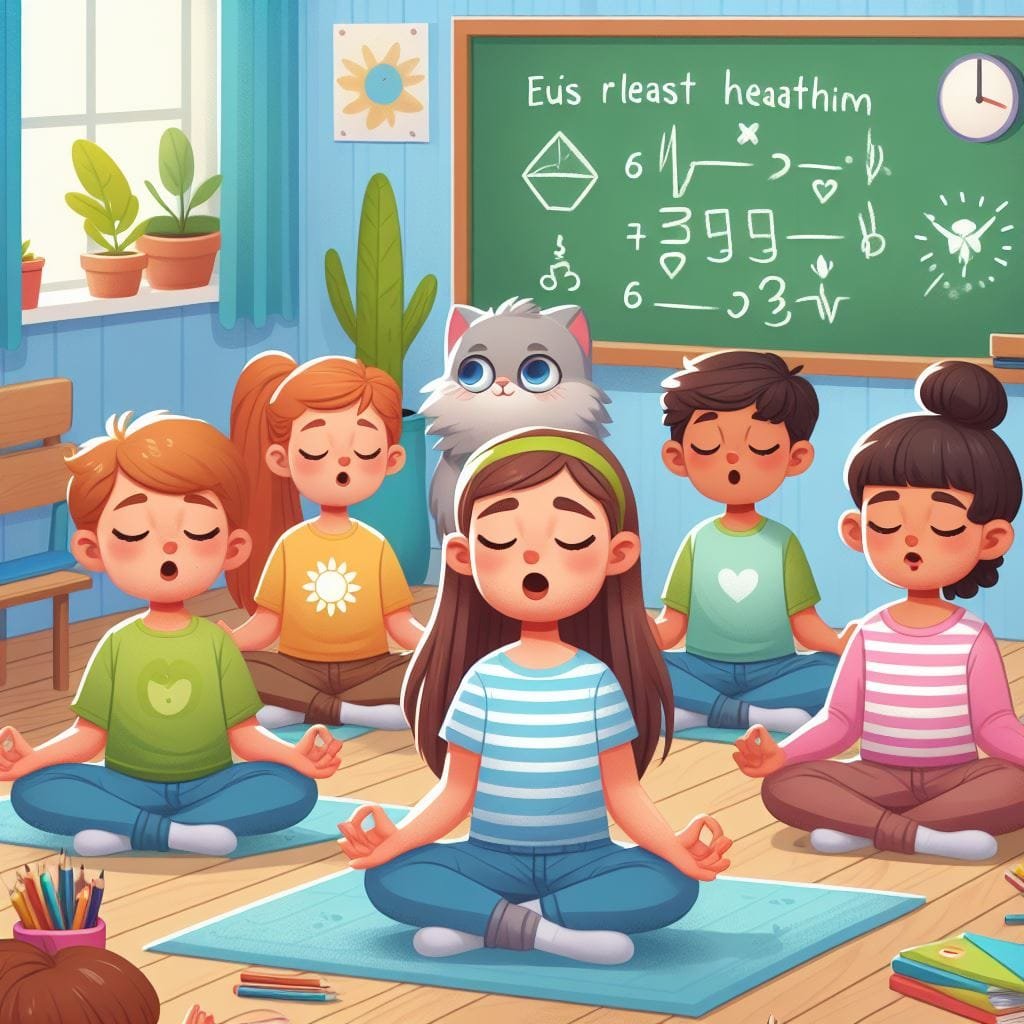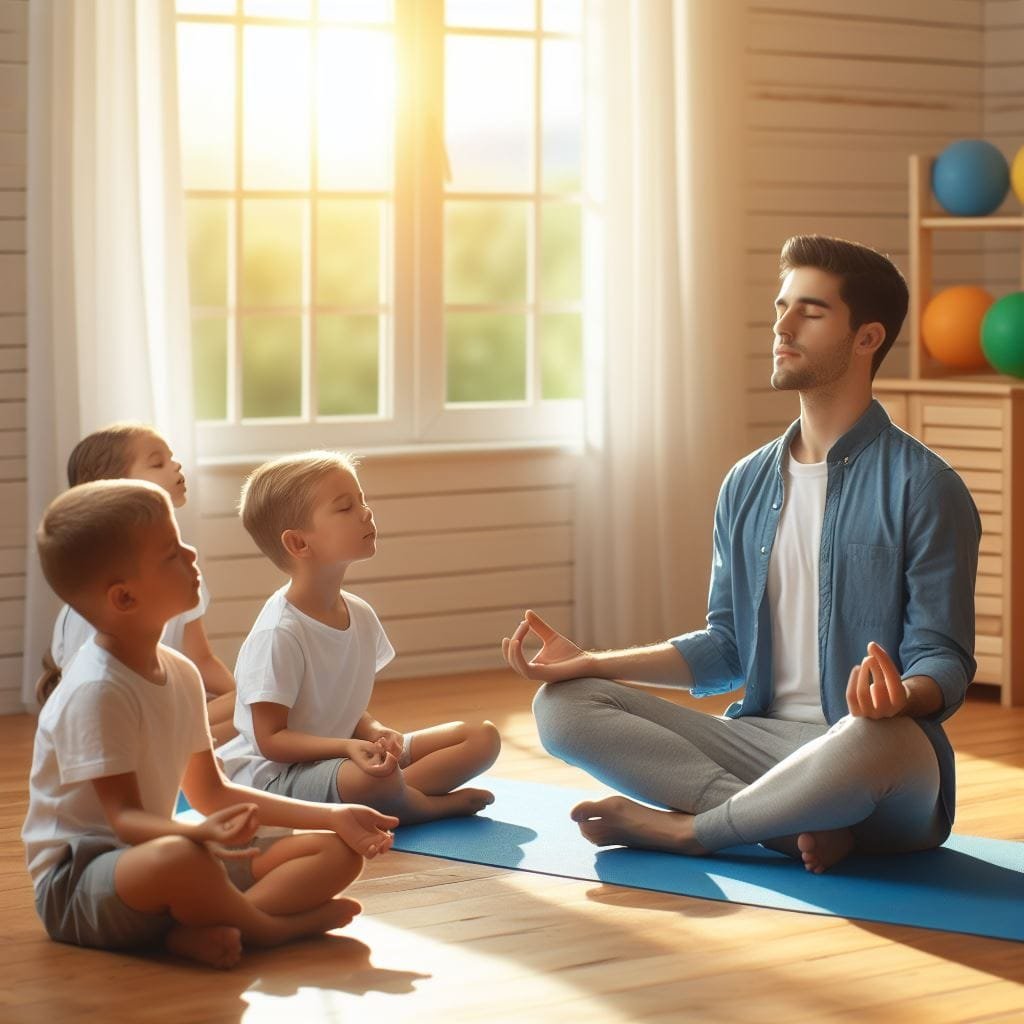Introduction
Welcome to a journey of exploring the wonderful world of teaching kids mindfulness through breathing exercises. In our fast-paced modern society, where children are constantly bombarded with stimuli, it becomes essential to equip them with tools that cultivate calmness and focus. Mindfulness, a practice rooted in ancient traditions, offers a path towards cultivating inner peace and emotional resilience for children.
Importance of teaching mindfulness to kids
Why is it important to introduce mindfulness to children? Well, for starters, it provides them with valuable skills that can help navigate the ups and downs of life. Mindfulness teaches kids how to be present in the moment, fully aware of their thoughts and feelings without judgment.
This ability allows them to respond to challenges with clarity and compassion. Mindfulness also helps children develop self-regulation skills.
By learning how to pay attention intentionally and non-judgmentally, they become more adept at managing their emotions effectively. This practice empowers them to foster healthier relationships, make better decisions, and cope with stressors that come their way.
Benefits of incorporating breathing exercises
Breathing exercises serve as an essential component of teaching mindfulness to kids. When practiced regularly, these exercises offer a wealth of benefits for their overall well-being.
Firstly, by engaging in simple yet intentional breathing techniques like belly breathing – where they consciously breathe from their diaphragm – children learn how to tap into the calming power of deep breaths. Deep breathing triggers relaxation responses in the body by activating the parasympathetic nervous system.
Through this process, they can reduce anxiety levels and promote a sense of inner tranquility. Incorporating breathwork into mindfulness practices also helps enhance concentration skills in children.
By focusing on counting breaths or engaging in animal-themed breaths, they learn to direct their attention and anchor their minds to the present moment. These exercises improve their ability to concentrate, which can have a positive impact on academic performance and overall productivity.
Understanding Mindfulness
Definition and Concept of Mindfulness
Mindfulness, in simple terms, refers to the act of being fully present and aware of one’s thoughts, feelings, and surroundings in the present moment. It involves paying attention to our experiences without judgment or attachment.
For children, mindfulness can be seen as an empowering practice that enables them to cultivate emotional intelligence and self-awareness. At its core, mindfulness encourages children to observe their thoughts and emotions without getting carried away by them.
It teaches them to approach situations with curiosity and openness rather than reacting impulsively. By developing this skill, kids learn how to remain calm and centered even when faced with challenging situations.
How Mindfulness Helps Children in Their Daily Lives
Practicing mindfulness offers numerous benefits for children’s overall well-being. Firstly, it enhances their ability to regulate emotions by helping them recognize their feelings before reacting impulsively.
This improved emotional regulation fosters better communication skills, reduces conflicts with peers, and promotes a more positive social environment. Moreover, mindfulness empowers kids with tools for managing stress and anxiety.
By being mindful of their breathing patterns during stressful moments, children can activate their body’s relaxation response and find a sense of calm amidst chaos. Additionally, regular mindfulness practice has been linked to better focus and concentration in children’s academic pursuits.
Furthermore, studies have shown that mindfulness can improve sleep quality in children by reducing racing thoughts before bedtime.
It also helps build resilience by teaching kids how to bounce back from setbacks more effectively. ,
understanding mindfulness as both a state of awareness and an essential life skill equips children with invaluable tools for emotional self-regulation, stress reduction, improved focus, enhanced sleep quality, and increased resilience.
The Science Behind Breathing Exercises

Explaining the Connection between Breath and Emotions
Have you ever noticed how your breath changes when you’re feeling stressed or anxious? It’s not just a coincidence.
Our breath and emotions are deeply connected, and understanding this connection is crucial in teaching kids mindfulness through breathing exercises. When we feel afraid or worried, our body triggers the “fight-or-flight” response, which causes shallow and rapid breathing.
On the other hand, when we are calm and relaxed, our breath becomes slow and deep. By explaining this connection to children, we can help them recognize how their breath can influence their emotional state.
Once they understand that taking control of their breath can impact how they feel inside, it empowers them to regulate their emotions more effectively. Teaching kids mindfulness through breathing exercises gives them a powerful tool to navigate challenging situations by simply turning their attention towards their breath.
How Deep Breathing Affects the Brain and Body
Deep breathing exercises have remarkable effects on both the brain and body – it’s like giving ourselves a mini reset button! When we take slow, deep breaths, it signals the brain to activate the parasympathetic nervous system, responsible for relaxation responses. This leads to decreased heart rate, lowered blood pressure, and reduced levels of stress hormones like cortisol.
In terms of brain function, deep breathing enhances oxygen flow to the prefrontal cortex – the area responsible for decision-making and problem-solving skills. This increased oxygenation improves cognitive functioning while promoting clarity of thought.
Additionally, deep breathing stimulates the release of endorphins – those feel-good neurotransmitters that boost mood and overall well-being. By emphasizing these physiological benefits of deep breathing to children during mindfulness activities, we help them grasp not only its calming effects but also its positive impact on their mental sharpness and overall health.
Conclusion
Understanding the science behind breathing exercises is a vital aspect of teaching kids mindfulness. By explaining how breath and emotions are interconnected, we can empower children to take control of their emotional state through conscious breathing. Moreover, educating them about the transformative effects of deep breathing on both the brain and body enables them to appreciate the holistic benefits of practicing mindfulness.
So, let’s dive deeper into the practical side of teaching kids mindfulness through various breathing exercises. By exploring different techniques and incorporating imaginative elements, we can create a fun and engaging experience for children while instilling in them invaluable skills for self-awareness, emotional regulation, and overall well-being.
Getting Started: Simple Breathing Techniques for Kids
Belly breathing: Teaching kids to breathe from their diaphragm
When it comes to teaching kids mindfulness through breathing exercises, belly breathing is a fundamental technique to start with. This technique helps children focus on their breath and learn how to breathe deeply from their diaphragm.
To introduce belly breathing, find a quiet and comfortable space where your child can sit or lie down. Begin by explaining that we often take shallow breaths from our chest, but belly breathing allows us to take deeper breaths that help us relax and focus better.
Encourage your child to place one hand on their chest and the other on their belly. Instruct them to take a slow breath in through the nose, feeling the belly rise like a balloon, while keeping the chest still.
Then, exhale slowly through the mouth, allowing the belly to fall back down. Repeat this process several times until your child feels comfortable with the movement.
Step-by-step instructions for belly breathing technique:
1. Find a comfortable spot where your child can sit or lie down. 2. Ask your child to place one hand on their chest and another on their belly.
3. Instruct them to take a slow breath in through their nose for about 4 seconds while feeling their stomach rise like a balloon. 4. Hold the breath gently for 1-2 seconds.
5. Exhale slowly through the mouth for about 6 seconds while letting the stomach fall back down. 6. Repeat this process for several cycles of deep belly breathing.
Benefits of belly breathing for relaxation and focus:
Belly breathing offers numerous benefits for children’s well-being and concentration skills. By practicing this technique regularly, children can develop better self-regulation as they learn how to calm themselves down during moments of stress or anxiety.
Belly breathing also helps in reducing physical tension, promoting relaxation in the body and mind. Moreover, this breathing technique enhances their focus and attention span.
Deep belly breaths deliver more oxygen to the brain, which improves cognitive function and mental clarity. When children engage in belly breathing exercises, they become more attuned to their breath and learn to shift their attention from external distractions to their internal state.
Counting breaths: Helping kids develop concentration skills
Counting breaths is another effective mindfulness exercise that can help children develop concentration skills. This technique encourages them to focus on the rhythm of their breath while counting each inhale and exhale.
To introduce counting breaths, find a quiet space where your child can sit comfortably. Start by explaining that counting breaths helps train the mind to stay present and focused.
Instruct your child to take a deep inhale through the nose while mentally counting ‘one.’ Then, as they exhale slowly through the mouth, they count ‘two.’ Encourage them to continue counting up until ten, then start over again from one. If their mind wanders or they lose track of counting, reassure them that it’s normal and simply ask them to start again.
Guiding children through counting breaths exercise:
1. Find a quiet space where your child can sit comfortably.
2. Instruct your child to take a deep inhale while mentally counting ‘one.’
3. As they exhale slowly through the mouth, tell them to count ‘two.’
4. Encourage them to continue counting up until ten.
5. If they lose track or get distracted during counting, gently guide them back by asking them to start again from one.
6. Repeat this process for several rounds of focused breathing.
Enhancing attention span through focused breathing:
Counting breaths is an excellent technique for improving children’s concentration skills. By engaging in this exercise, kids learn to anchor their focus on the present moment, allowing distractions to fade away.
Regular practice of counting breaths cultivates their ability to sustain attention and resist getting carried away by thoughts or external stimuli. Additionally, counting breaths helps children develop self-discipline as they build the habit of staying with the breath without giving in to impulsive distractions.
This skill becomes particularly valuable in academic settings, where maintaining focus for extended periods is essential for tasks such as studying or taking tests. By training their attention through counting breaths, children gain a valuable tool that enhances their overall learning experience and boosts their academic performance.
Remember to be patient and supportive while guiding your child through these breathing exercises. With time and consistent practice, they will gradually develop a deeper understanding of mindfulness and experience the remarkable benefits it offers.
Fun Variations of Breathing Exercises for Kids
Animal-themed breaths: Engaging imagination while practicing mindfulness
When it comes to teaching mindfulness to kids, incorporating their vivid imagination can make the experience even more enjoyable. Animal-themed breaths are a fantastic way to engage their creative minds while practicing mindfulness. Picture this: your little one takes a deep inhale and then lets out a fierce lion’s breath, complete with a mighty roar!
This technique, also known as “lion’s breath,” not only encourages deep breathing but also helps release tension and stress. As they imitate the roar of a lion, they can imagine themselves being mighty and strong, just like the king of the jungle.
Another delightful animal-themed breathing exercise is the “bunny breath.” Instruct your child to take quick short sniffs through their nose, mimicking the way bunnies sniff the air. Encourage them to visualize themselves hopping lightly like bunnies while they practice this technique.
Not only will it help them connect with their breath, but it will also fill them with a sense of playfulness and lightness. One more animal-inspired breathing exercise that kids love is known as “snake breath.” Ask your child to take a long deep inhale through their nose while hissing like a snake as they exhale slowly through their mouth.
This technique promotes relaxation and teaches children how to control their exhalation by lengthening it intentionally. They can pretend to slither along smoothly as they breathe out like snakes do, giving them an opportunity to explore movement alongside mindful breathing.
Mindful storytelling: Combining breathing exercises with storytelling
Storytelling has always captivated children’s minds, transporting them into magical worlds filled with adventure and wonder. By combining breathing exercises with storytelling, we can create an immersive experience that enhances both mindfulness and active listening skills. Here’s how it works: as you weave a captivating tale, you pause at specific moments to instruct the children to take a deep breath and exhale slowly.
These mindful pauses allow them to connect with their breath, grounding them in the present moment. For example, imagine telling a story about a brave knight on a quest to rescue a magical treasure.
At pivotal points in the story, you could say something like, “And as the knight stood before the enchanted castle, he took a deep breath in, feeling strength filling his body, and then exhaled slowly, readying himself for the challenges ahead.” Encourage children to follow along with their own deep inhales and exhales during these pauses. This engaging technique not only makes storytelling more interactive but also helps kids develop focus and attentiveness while enjoying an enchanting narrative.
Through mindful storytelling, children can learn valuable lessons about self-regulation and emotional awareness. As they embody characters breathing deeply during certain story moments—whether it’s facing fears or finding inner peace—they cultivate empathy and connect with their own emotions on a deeper level.
Remember that incorporating creativity into these breathing exercises is crucial. Allow children to use their imaginations freely as they explore animal-themed breaths or immerse themselves in captivating stories—the possibilities are endless!
Teaching Mindfulness in Different Settings
School environment: Integrating mindfulness into the classroom routine
Incorporating mindfulness practices into the school environment can have a profound impact on students’ overall well-being and academic performance. Teachers can seamlessly weave short breathing exercises into their daily routines to create moments of calm and focus.
For instance, at the beginning of each class, teachers can lead a brief guided breathing exercise, encouraging students to close their eyes and take a few deep breaths. This simple practice helps establish a peaceful atmosphere conducive to learning.
Tips for teachers on incorporating short breathing exercises during class:
1. Keep it brief: Since class time is limited, choose breathing exercises that can be completed within a few minutes. Quick techniques like “Box Breathing,” where students inhale for four counts, hold their breath for four counts, exhale for four counts, and then hold again for four counts, are effective options.
2. Make it fun: To engage younger students, use creative visuals or props related to mindful breathing techniques. For example, teachers can introduce “Bubble Breathing,” where children imagine blowing bubbles slowly while taking deep breaths.
3. Consistency is key: Incorporate these practices regularly throughout the school week to establish a mindful routine that becomes second nature to students. By doing so, they will reap the benefits of increased focus and reduced stress levels consistently.
Benefits of regular mindfulness practice in academic performance:
Regular mindfulness practice enhances cognitive abilities such as attention span, memory retention, and problem-solving skills – all crucial components for successful academic achievement. By integrating mindfulness into the classroom routine through short breathing exercises or other techniques such as mindful listening activities or body scan meditations during breaks, teachers provide students with valuable tools for self-regulation and stress reduction.
Home environment: Making mindfulness a part of daily family life
Creating a mindful environment at home helps children cultivate mindfulness habits that extend beyond the school setting. Parents can incorporate simple breathing exercises into daily routines, fostering an atmosphere of calm and presence. Here are some ideas to make mindfulness a part of your family’s life:
Creating:
1. Morning mindfulness: Start the day with a mindful breathing exercise as a family. Gather in a quiet spot and sit comfortably, taking turns leading the group through deep breathing exercises or guided meditations. 2. Mindful mealtimes: Encourage everyone to take a moment before meals to pause, take a few deep breaths, and express gratitude for the food and each other’s company.
This practice helps foster mindful eating habits and promotes connection within the family. 3. Bedtime relaxation: Before bed, engage in calming activities like reading or practicing gentle stretching together.
End the day with a brief breathing exercise to help children unwind and transition into restful sleep. By incorporating mindfulness practices into their daily lives, families provide children with essential tools for managing stress, improving focus, and nurturing emotional well-being.
Conclusion
Teaching kids mindfulness through breathing exercises is not only beneficial but also empowering for their overall development. By integrating these practices into school routines and home environments, children gain valuable skills in self-regulation, concentration, and emotional well-being. The combination of short breathing exercises during class time increases focus and academic performance while creating an environment conducive to learning. Similarly, incorporating mindfulness into daily family life allows children to cultivate positive habits that contribute to their overall happiness and resilience. By prioritizing mindfulness education for kids today, we pave the way for healthier generations tomorrow – equipped with invaluable tools to navigate life’s challenges with grace and ease





